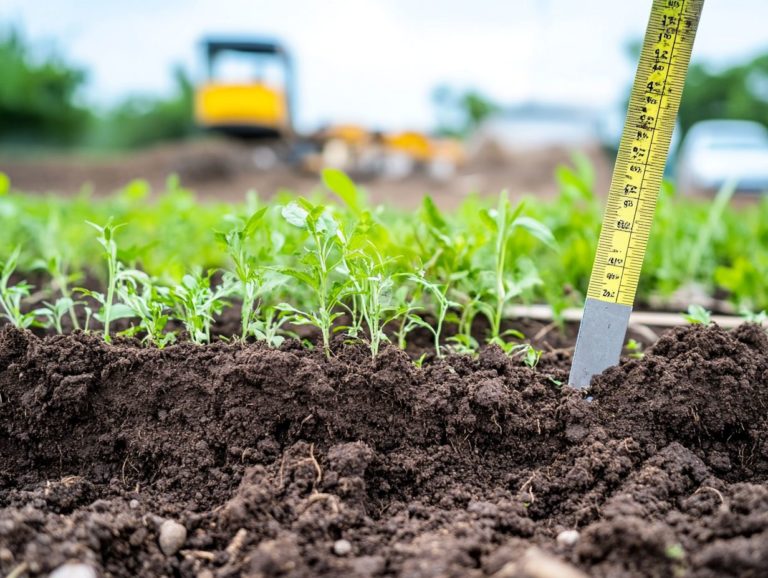Soil Amendments: When and How to Use Them
Soil amendments are essential for enhancing the health and productivity of your garden or landscape. Choosing the right types of materials to use is crucial.
Whether you re a seasoned gardener or just beginning your horticultural journey, understanding soil amendments is vital for nurturing your plants effectively. This article delves into the myriad benefits of using soil amendments, guiding you on when to apply them and exploring the different types available both organic and inorganic, including materials like compost and vermiculite.
It also highlights best practices for application and common pitfalls to avoid. This ensures that your gardening efforts translate into vibrant results.
Dive in to uncover the secrets to thriving soil and flourishing plants!
Contents
Key Takeaways:

- Soil amendments can improve soil quality and promote healthier plant growth.
- It is important to identify soil deficiencies before deciding to use amendments.
- Proper application methods and avoiding common mistakes can lead to successful use of soil amendments.
Understanding Soil Amendments
Understanding soil amendments is essential for any gardener or agricultural enthusiast looking to improve their soil’s quality and structure, especially in sandy or clay textures. These materials enhance the soil s properties, providing vital nutrients like nitrogen and phosphorus, which boost plant growth.
By incorporating both organic and inorganic amendments, you can effectively manage soil texture and water retention. This ensures your plants flourish in a range of climates, from sandy soils to dense clay.
This comprehensive approach supports robust root development and strengthens the soil s ecosystem. It promotes sustainability in your gardening practices, enhancing the overall quality of the environment.
What are Soil Amendments?
Soil amendments are the secret elixirs you can add to your soil to enhance its physical or chemical properties, such as texture and nutrient levels. This ultimately boosts fertility and supports robust plant growth.
These amendments fall into two main categories: organic and inorganic, each offering unique benefits. Organic amendments like compost and vermiculite enrich your soil with nutrients, improve water retention, and promote beneficial microbial activity.
Compost not only supplies essential nitrogen, phosphorus, and potassium but also improves the overall structure of your soil, aiding better water retention and root health. In contrast, inorganic amendments like wood ashes deliver quick nutrient boosts, particularly potassium, making them ideal for immediate needs.
By grasping the nuances of these various soil amendments, you can refine your gardening or farming strategy. This allows you to cultivate thriving, sustainable plants with ease.
Benefits of Using Soil Amendments
The advantages of using soil amendments are numerous. They substantially improve soil quality and foster healthier plant growth by enhancing nutrient availability and water retention.
Mixing various amendments into your gardening routine can work wonders! They help address issues like poor soil structure and nutrient deficiencies.
These enhancements contribute to stronger root systems, improved hydration, and ultimately a more fruitful garden. Choosing the right amendments, such as garden lime or sulfur, helps achieve a balanced pH level for optimal plant growth, whether you’re working with sandy soils or dense clay.
Start improving your soil today for a vibrant, thriving garden tomorrow!
Improving Soil Quality and Plant Growth
Improving soil quality is vital for plant growth. Soil amendments enrich the soil with essential nutrients.
Soil amendments enhance soil texture, nutrient content, and water retention. They make a significant difference in your garden’s health.
When you incorporate compost into the soil, you introduce a diverse range of nutrients and improve the soil structure, allowing for better root penetration.
Coconut Coir, derived from coconut husks, is an excellent amendment in drought-prone areas because it retains moisture more effectively than peat, enhancing water availability for your plants. Both materials, tailored to your specific environmental conditions, contribute to healthier ecosystems and foster more resilient plant growth.
When to Use Soil Amendments

Knowing when to apply soil amendments is game-changing for your garden! This process begins with identifying soil deficiencies through thorough testing.
Identifying Soil Deficiencies
Identifying soil deficiencies is crucial before applying any amendments. This enables you to target specific nutrient needs and enhance soil health effectively.
By observing your garden, you can spot signs like poor plant growth, yellowing leaves, or stunted development, which often indicate the need for additional nutrients. These symptoms often show imbalances in essential nutrients such as nitrogen, phosphorus, or potassium.
Start by collecting samples from various areas of your garden and either send them to a lab or use a home testing kit. The results will illuminate pH levels and nutrient availability, guiding you in selecting and applying the right amendments to restore and rejuvenate your soil. This thoughtful approach ultimately fosters healthier, more vibrant plants.
Types of Soil Amendments
You ll discover two primary categories of soil amendments: organic and inorganic. Each type plays a distinct role in enhancing soil structure and enriching nutrient content, tailored to meet your gardening or landscaping needs.
Organic vs. Inorganic Amendments
Organic amendments, like compost and wood bark, offer essential nutrients that release slowly over time. In contrast, inorganic options, such as ammonium sulfate and garden lime, provide quick fixes for nutrient lack.
This distinction is significant for your gardening practices, especially when considering soil health and plant growth. Organic amendments enhance soil structure, improving its ability to retain water and cultivating a thriving ecosystem of beneficial microbes. This gradual release of nutrients is particularly beneficial in raised garden beds, where maintaining consistent moisture levels is paramount for plant health.
On the other hand, inorganic amendments are fantastic for providing quick nutrient boosts, making them the go-to choice for nutrient-deficient soils needing immediate attention, such as sandy or poor clay soils. However, leaning too heavily on inorganic options can result in nutrient leaching, ultimately harming soil quality over time and impacting the overall health of your garden.
By understanding these nuances, you can select the right type of amendment tailored to your specific gardening conditions and long-term objectives.
How to Apply Soil Amendments
Applying soil amendments correctly is crucial for achieving the desired enhancements in soil quality. This practice ensures that your plants receive the essential nutrients they need, such as nitrogen and potassium, to thrive.
By paying attention to the proper techniques, you set the stage for a flourishing garden that reflects your care and expertise.
Methods and Best Practices

Using proper methods and best practices for applying soil amendments can greatly improve their effectiveness in boosting soil nutrient levels.
For example, mixed incorporation is often effective. It allows amendments like compost and vermiculite to blend seamlessly into the soil and ensures an even nutrient distribution.
On the other hand, surface applications can be a quick fix, especially in established gardens or lawns where tilling might disturb existing plants. Banding focuses on specific areas, which minimizes waste and maximizes nutrient uptake for your crops.
Timing is key! Apply amendments just before a planting cycle or during active growth phases for the best results on nutrient uptake and overall plant health.
Understanding your soil type is equally vital. Sandy soils may need more frequent applications, while clay soils could benefit from deeper, less frequent treatments to improve aeration and drainage.
Common Mistakes to Avoid
Avoiding common mistakes when applying soil amendments is essential to get the most out of them and improve soil quality.
By following best practices and using organic materials, you can enhance the health and vitality of your soil, leading to fruitful results in your gardening or agricultural endeavors.
Tips for Successful Application
Implementing effective soil amendment strategies can significantly enhance plant health and improve soil conditions over time.
Begin by preparing the soil: clear away debris, loosen compacted areas, and check the pH this is a measure of how acidic or basic your soil is to identify specific nutrient needs before adding amendments.
Once you’ve identified the necessary adjustments, evenly distribute the amendments and mix them thoroughly into the soil. This ensures they reach the root zone where they can be most beneficial.
Keep an eye out for nutrient deficiency signs after applying the amendments. Look for yellowing leaves that may indicate a lack of nitrogen or stunted growth that could suggest potassium shortages.
Incorporating organic matter like compost can boost soil structure, while adding targeted fertilizers can address specific deficiencies, ultimately promoting vibrant and robust plant life.
Frequently Asked Questions
When is the best time to use soil amendments?
Spring is the perfect time to boost your soil with amendments, ideally before planting. Applying in the fall after harvesting also works well, giving the amendments time to break down and improve the soil for the next growing season.
What types of soil amendments should I use?

The type of soil amendment you should use depends on your soil’s specific needs. Common options include compost, manure, peat moss, and vermiculite. It’s best to have your soil tested to determine which amendment will be most beneficial.
How often should I apply soil amendments?
The frequency of soil amendment applications will depend on the specific type and your soil’s needs. Generally, it is recommended to apply them every 2-3 years, or as necessary.
Can I use too much soil amendment?
Yes, using too much can harm your plants. It can lead to nutrient imbalances and hinder growth. Always follow recommended application rates and test your soil to find the right amount.
Should I mix soil amendments into the soil or just apply on top?
Mixing soil amendments into the soil is recommended for better distribution and effectiveness. However, some amendments, like mulch, can be applied on top as a protective layer.
Are there any risks to using soil amendments?
There are potential risks, such as introducing weed seeds or harmful bacteria. To minimize these risks, use high-quality, well-composted amendments and mix them thoroughly into the soil.
Don’t wait! Test your soil today and give your plants the boost they need!






